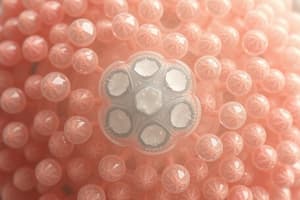Podcast
Questions and Answers
Which type of tissue is primarily responsible for the absorption of nutrients?
Which type of tissue is primarily responsible for the absorption of nutrients?
- Nervous Tissue
- Muscle Tissue
- Epithelial Tissue (correct)
- Connective Tissue
What structural characteristic distinguishes cardiac muscle tissue from skeletal muscle?
What structural characteristic distinguishes cardiac muscle tissue from skeletal muscle?
- Non-striated appearance
- Voluntary control
- Involuntary control (correct)
- Striated appearance
Which of the following statements about tissue regeneration is correct?
Which of the following statements about tissue regeneration is correct?
- Connective tissue has no regenerative abilities.
- Muscle tissue has a high capacity for regeneration.
- Nervous tissue regenerates effectively after injury.
- Epithelial tissue has a high capacity for regeneration. (correct)
Which type of connective tissue is characterized by a matrix filled with fat cells?
Which type of connective tissue is characterized by a matrix filled with fat cells?
Which function is primarily associated with nervous tissue?
Which function is primarily associated with nervous tissue?
What type of epithelial tissue consists of multiple layers of cells?
What type of epithelial tissue consists of multiple layers of cells?
Flashcards are hidden until you start studying
Study Notes
Definition
- Tissue: A group of similar cells that work together to perform a specific function.
Types of Tissues
-
Epithelial Tissue
- Covers body surfaces and lines cavities.
- Functions: protection, absorption, secretion, sensation.
- Types: simple (single layer) and stratified (multiple layers).
-
Connective Tissue
- Supports, binds, and protects other tissues.
- Comprises cells, fibers, and a ground substance.
- Types: loose, dense, adipose, cartilage, bone, blood.
-
Muscle Tissue
- Responsible for movement.
- Types:
- Skeletal: voluntary, striated, attached to bones.
- Cardiac: involuntary, striated, heart muscle.
- Smooth: involuntary, non-striated, found in organs.
-
Nervous Tissue
- Composed of neurons and glial cells.
- Functions: transmission of signals, processing information.
Functions of Tissues
- Protection: Epithelial tissue acts as a barrier against pathogens.
- Support and Structure: Connective tissue provides framework and strength.
- Movement: Muscle tissue enables bodily movements.
- Communication: Nervous tissue facilitates signal transmission.
Tissue Repair and Regeneration
- Epithelial and connective tissues have a high capacity for regeneration.
- Muscle and nervous tissues have limited regenerative abilities, often leading to scar formation.
Importance in Health and Disease
- Abnormal tissue growth can lead to tumors (benign or malignant).
- Tissue function is crucial in diagnosing diseases (biopsy analysis).
Definition
- Tissue consists of a group of similar cells collaborating to achieve a specific function.
Types of Tissues
-
Epithelial Tissue
- Functions include protection, absorption, secretion, and providing sensation.
- Classified into simple (single layer) and stratified (multiple layers).
-
Connective Tissue
- Serves to support, bind, and protect other tissues and organs.
- Composed of various cells, fibers, and ground substance.
- Examples include loose, dense, adipose, cartilage, bone, and blood.
-
Muscle Tissue
- Crucial for movement within the body.
- Skeletal Muscle: Voluntary and striated, connected to bones.
- Cardiac Muscle: Involuntary and striated, found in the heart.
- Smooth Muscle: Involuntary and non-striated, located in organs.
-
Nervous Tissue
- Made up of neurons that transmit signals and glial cells that support neurons.
- Vital for processing information and communication within the body.
Functions of Tissues
- Protection: Epithelial tissue serves as a barrier to pathogens.
- Support and Structure: Connective tissue provides the necessary framework and strength.
- Movement: Muscle tissue facilitates bodily movements, allowing for various physical activities.
- Communication: Nervous tissue is essential for transmitting signals throughout the body.
Tissue Repair and Regeneration
- Epithelial and connective tissues exhibit a high capacity for regeneration.
- Muscle and nervous tissues regenerate poorly, often resulting in scar formation after injury.
Importance in Health and Disease
- Abnormal tissue growth can result in tumors, which can be benign or malignant.
- Tissue functionality is critical for diagnosing diseases, often assessed through biopsy analysis.
Studying That Suits You
Use AI to generate personalized quizzes and flashcards to suit your learning preferences.




